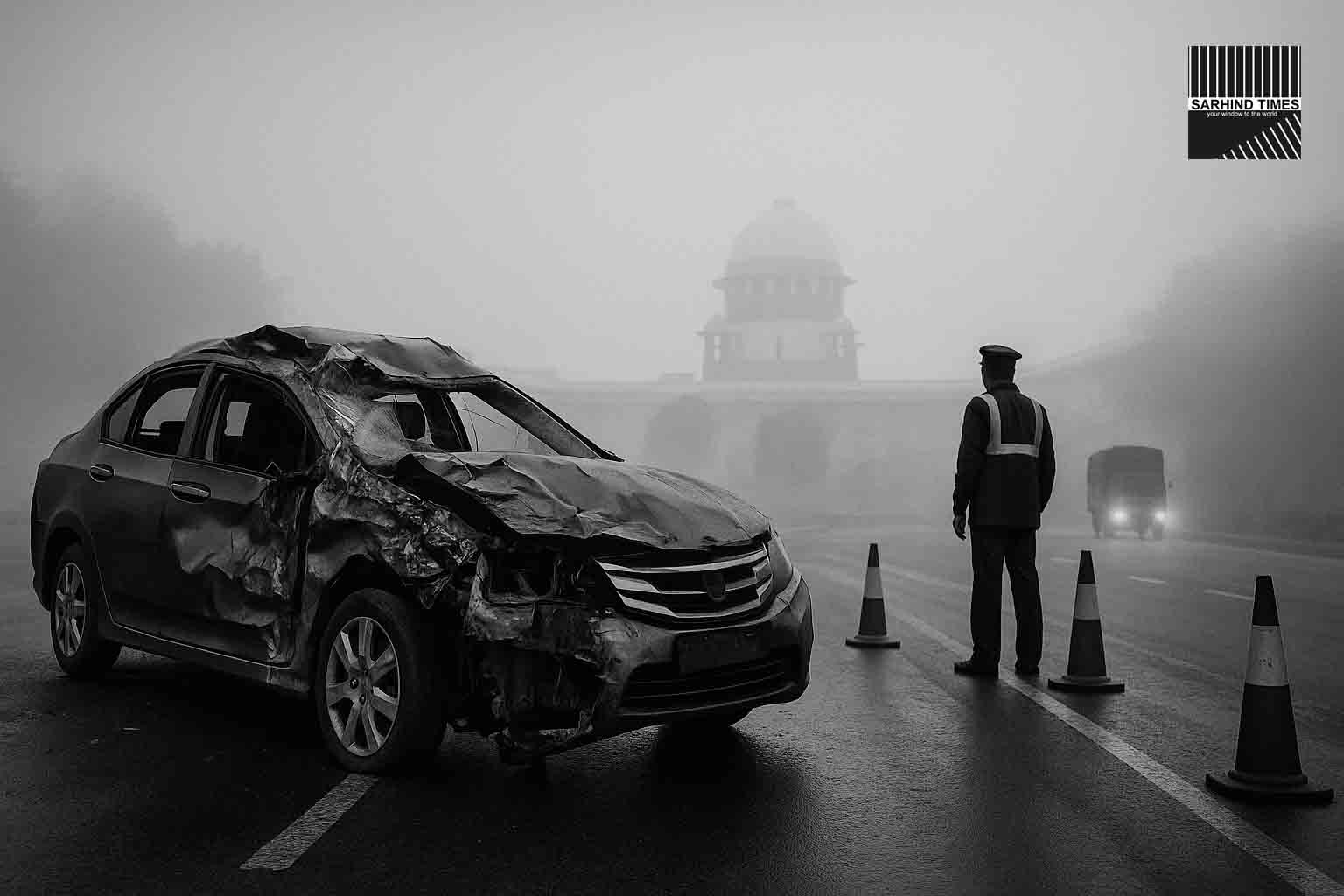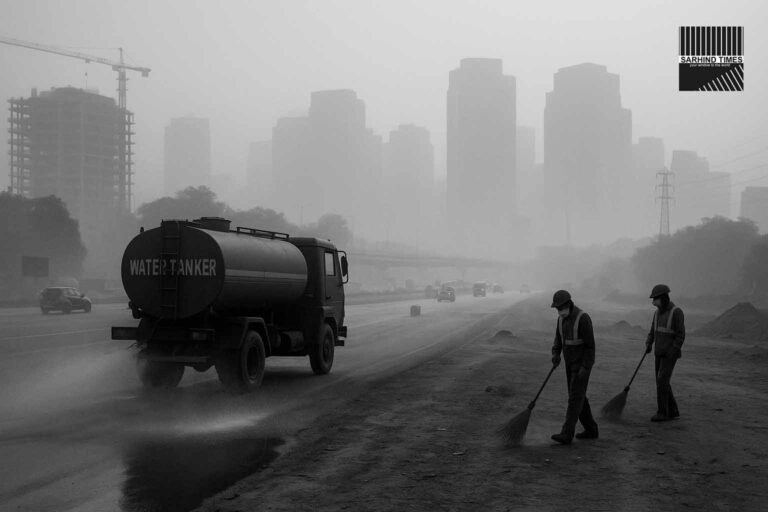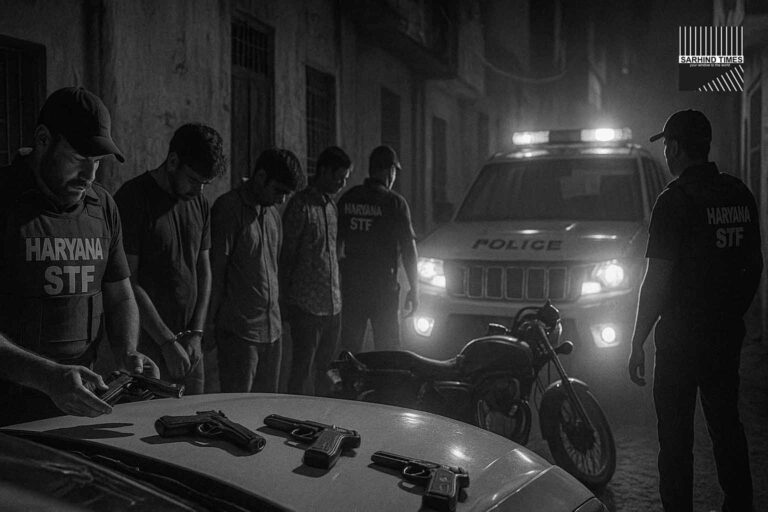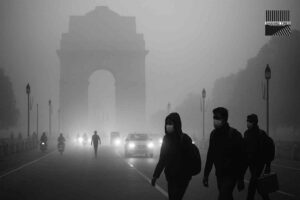A speeding truck carrying steel lost control on the Delhi–Jaipur Expressway in Manesar, crushing a cab and reigniting the debate over heavy-vehicle safety and highway enforcement during the festive rush.
Gurgaon | October 11, 2025
A routine morning commute turned fatal on Friday when a speeding truck loaded with steel bars rammed into a cab on the Delhi–Jaipur Expressway near Manesar, killing one and injuring two others.
The victim, Sandeep Kumar (28), an R&D engineer with Hero MotoCorp, was seated in the rear seat of a Swift Dzire when the accident occurred around 8:15 a.m. Police said the truck, unable to brake in time due to sudden congestion, crashed into the cab’s rear, propelling it into another vehicle ahead.
By the time authorities arrived, the truck driver had fled the scene.
The Collision: Seconds of Chaos
Eyewitnesses described a chilling sequence of events that lasted less than ten seconds.
“Traffic had slowed because of a temporary barricade near the toll section,” said Rajesh Yadav, a commuter who witnessed the crash. “The truck didn’t even attempt to brake—it just ploughed through.”
The steel-laden truck, registered in Rajasthan, was reportedly traveling well above the speed limit. The impact left the cab’s rear section crushed and glass strewn across multiple lanes.
“It was like a bomb had gone off,” said another witness. “Two men were screaming for help from inside the cab. The truck driver ran across the divider and disappeared toward a service lane.”
Police and expressway patrol teams rushed to the site within minutes. Sandeep Kumar was declared dead at the scene, while his colleagues—Rahul Chauhan and Vijay Meena—suffered multiple injuries and were shifted to Medanta Hospital in critical but stable condition.
Investigation Underway: CCTV, Registrations, and Missing Driver
Authorities from the Manesar police station have registered a case under sections 279 (rash driving) and 304A (causing death by negligence) of the Bharatiya Nyay Sanhita (BNS) 2023.
“We are scanning CCTV footage from toll plazas and nearby industrial zones,” said ACP (Traffic) Sukhbir Dahiya. “The truck’s registration number has been identified, and teams are tracking its owner in Rajasthan.”
Preliminary reports suggest the truck was overloaded, a common violation that increases stopping distance and reduces maneuverability. Investigators are also probing whether the vehicle’s brake system malfunctioned or whether driver fatigue played a role.
The Victim: A Promising Engineer, A Life Cut Short
Sandeep Kumar, a mechanical engineer from Rohtak, joined Hero MotoCorp’s R&D division in Gurugram in 2022. Known among colleagues for his quiet dedication and inventive streak, he had been working on an electric two-wheeler prototype.
“He was passionate about design and safety,” said Ankit Sharma, a colleague who visited the hospital. “Ironically, safety is what he kept advocating for—both on the roads and in our lab discussions.”
Family members from Rohtak reached Gurugram by noon. His father, Om Prakash, a retired schoolteacher, said Sandeep was the family’s eldest son and financial support.
“He used to call every morning after reaching office,” Om Prakash said quietly. “Today, the call never came.”
Rising Toll on the Delhi–Jaipur Expressway
The Delhi–Jaipur stretch of NH-48, once lauded as a model expressway, has become increasingly notorious for accidents—particularly near Manesar, Kherki Daula, and Bilaspur Chowk.
According to data from the Haryana Traffic Police, over 220 accidents were reported on this expressway in the past 10 months, with 64 fatalities—a rise of nearly 18% from 2024.
Officials attribute the spike to overspeeding, overloaded trucks, and poor lane discipline among both heavy and light vehicles.
“Nighttime speeding by long-haul trucks is a major problem,” said DSP (Highways) Neha Yadav. “Despite patrols, drivers often bypass speed cameras or remove license plates temporarily.”
Festive Rush and Fatigue: A Deadly Mix
The crash comes as highways witness increased traffic ahead of the festive season. Truckers, pressed by delivery deadlines, often drive for 16–18 hours straight without adequate rest.
“Drivers are overworked and underpaid,” said Ajay Bhatia, president of the All India Motor Transport Congress. “Many skip breaks to meet schedules. The system incentivizes risk.”
Road-safety advocates say India needs mandatory fatigue-monitoring systems and GPS-linked enforcement to curb such incidents.
“Technology can save lives if used intelligently,” said Kunal Anand, founder of SafeWheels India, a road safety NGO. “But until enforcement is consistent, highways will remain death corridors.”
Infrastructure Gaps: The Manesar Bottleneck
Despite multiple expansion projects, the Manesar–Bilaspur belt remains one of the most congested stretches of NH-48.
Frequent lane merging, encroachments near service roads, and incomplete flyovers cause erratic braking patterns that endanger commuters.
“This corridor handles both industrial and intercity traffic,” explained urban planner Dr. Ruchika Bhargava. “You have heavy trucks, office cabs, and two-wheelers fighting for space. It’s an accident waiting to happen.”
Local residents have long demanded dedicated freight lanes, nighttime truck restrictions, and better lighting, but progress has been slow.
Enforcement Challenges
Gurgaon traffic officials admit manpower shortages limit round-the-clock surveillance.
“We can’t be everywhere,” said a senior officer requesting anonymity. “There are over 250 km of highway jurisdiction, and just six patrol teams per shift.”
Speed cameras, often tampered with or rendered inoperative by dust accumulation, further weaken deterrence.
“Technology fails if not maintained,” the officer added.
The government’s Integrated Traffic Management System (ITMS)—designed to automatically detect violations—remains partially operational, awaiting full calibration across Haryana.
Public Outrage and Renewed Demands
As news of the crash spread, social media erupted with calls for accountability.
#GurgaonTraffic, #NH48, and #JusticeForSandeep trended regionally by evening.
“Another young life lost to negligence,” wrote one user. “When will we value human life more than delivery schedules?”
Road-safety advocates have urged authorities to increase penalties for overloading and hit-and-run offences under the new Bharatiya Nyay Sanhita.
The Legal Framework: Stricter, But Still Weakly Enforced
Under BNS Section 304A, causing death by negligence carries up to two years imprisonment, a penalty activists say is too mild to deter reckless driving.
“These are not ‘accidents’—they are preventable crimes,” argued Supreme Court lawyer Vandana Sehgal, who campaigns for highway reforms. “When a truck driver speeds with steel rods unsecured, it’s gross negligence, not fate.”
The Supreme Court Committee on Road Safety has also repeatedly directed states to install automated enforcement corridors, but compliance remains patchy.
Voices from the Ground: Truckers Speak
Truck drivers interviewed at Dharuhera and Kherki Daula rest areas painted a grim picture of working conditions.
“We’re blamed for everything,” said Ramesh Patil, a driver from Nashik. “But we drive 600–700 km a day because owners push us. The fines are high, diesel prices higher.”
Patil said most drivers earn ₹15,000–20,000 a month, with no insurance or rest allowances.
“If we stop to sleep, we lose a day’s wage,” he added.
Experts say until the logistics ecosystem incentivizes safety, enforcement alone will remain ineffective.
Corporate Response: Hero MotoCorp Issues Statement
Following the accident, Hero MotoCorp released a condolence message:
“We are deeply saddened by the tragic loss of our colleague Sandeep Kumar. Our thoughts are with his family and colleagues. We are extending all possible support.”
Company representatives visited Medanta Hospital and coordinated with local authorities for post-mortem formalities.
The Broader Picture: India’s Road Safety Crisis
India records over 1.6 lakh road fatalities annually, according to the Ministry of Road Transport and Highways (MoRTH)—translating to one death every three minutes.
Heavy vehicles account for nearly 30% of fatal crashes, though they represent less than 10% of total road traffic.
“Road safety isn’t just a policing issue—it’s a national public health emergency,” said Dr. Piyush Tiwari, founder of the SaveLIFE Foundation. “We need design, education, and accountability in equal measure.”
Civic and Industry Collaboration: A Way Forward
The Haryana Road Safety Authority has announced plans to pilot AI-driven traffic surveillance and infrared night cameras on key expressway points by early 2026.
Additionally, Hero MotoCorp, Maruti Suzuki Foundation, and Honda 2Wheelers have jointly pledged funds for awareness programs and driver rest shelters along NCR highways.
“Corporate partnerships can fill enforcement gaps,” said Road Safety Officer Meena Bhati. “Companies have a moral stake when their own employees are victims.”
Human Cost: Behind the Statistics
For Sandeep’s family, numbers mean little.
His younger sister Neha, a college student, said through tears:
“He promised to bring me a scooter for Diwali. Now they’re bringing him home instead.”
His friends have started an online petition demanding a dedicated memorial for road accident victims in Gurgaon and stricter cargo-vehicle policing.
“We’ve normalized tragedy,” said friend Rahul Meena. “If nothing changes, another Sandeep will die next week.”
Editorial Insight: The Road Not Repaired
The tragedy highlights a recurring theme in India’s urban growth story — highways expanding faster than discipline, enforcement lagging behind ambition.
Each crash replays a cycle of outrage, inquiry, and amnesia. The Delhi–Jaipur Expressway, conceived as a corridor of commerce, now mirrors the costs of carelessness.
As festival traffic surges and infrastructure stretches thin, commuters, contractors, and carriers are reminded: safety is not a slogan, it’s survival.
“Every crash is a question we haven’t answered yet,” said traffic psychologist Dr. Renu Arora. “And until we do, our progress will keep bleeding on asphalt.”
#Gurgaon #RoadSafety #DelhiJaipurExpressway #Manesar #Traffic #Police #NH48 #SarhindTimes

























+ There are no comments
Add yours